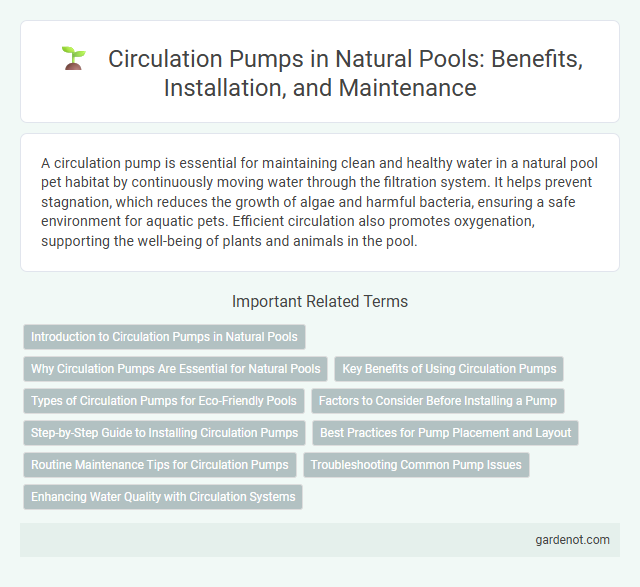A circulation pump is essential for maintaining clean and healthy water in a natural pool pet habitat by continuously moving water through the filtration system. It helps prevent stagnation, which reduces the growth of algae and harmful bacteria, ensuring a safe environment for aquatic pets. Efficient circulation also promotes oxygenation, supporting the well-being of plants and animals in the pool.
Introduction to Circulation Pumps in Natural Pools
Circulation pumps play a crucial role in natural pools by maintaining water movement essential for filtration and oxygenation. These pumps help distribute nutrients and prevent stagnation, supporting healthy aquatic ecosystems without chemicals. Energy-efficient models are preferred to ensure sustainability and reduce operational costs in natural pool maintenance.
Why Circulation Pumps Are Essential for Natural Pools
Circulation pumps are essential for natural pools because they maintain continuous water movement, ensuring proper oxygenation and preventing stagnation that can lead to algae growth and water quality issues. By facilitating the flow through biological filters and plant zones, circulation pumps support the natural purification process and promote a balanced ecosystem within the pool. Efficient water circulation also helps distribute nutrients evenly, contributing to cleaner, clearer water and a healthier environment for aquatic life.
Key Benefits of Using Circulation Pumps
Circulation pumps in natural pools enhance water quality by promoting continuous movement, preventing stagnation and reducing algae growth. These pumps improve filtration efficiency by evenly distributing water through the filtration system, resulting in clearer, cleaner water. Energy-efficient circulation pumps also reduce overall maintenance costs and contribute to a healthier aquatic environment.
Types of Circulation Pumps for Eco-Friendly Pools
Circulation pumps for eco-friendly natural pools include variable-speed, magnetic drive, and solar-powered models, each designed to optimize energy efficiency and reduce environmental impact. Variable-speed pumps adjust flow rates to match pool needs, minimizing electricity consumption, while magnetic drive pumps eliminate shaft seals, reducing maintenance and leakage risks. Solar-powered circulation pumps harness renewable energy, providing sustainable water movement without relying on conventional power sources.
Factors to Consider Before Installing a Pump
Selecting the right circulation pump for a natural pool depends on factors such as pool size, water volume, and desired flow rate to ensure efficient water movement and filtration. Energy efficiency and pump durability are crucial to minimize operational costs and ensure long-term functionality in outdoor environments. Proper sizing and compatibility with natural pool filtration systems are essential to maintain water clarity and balance aquatic ecosystems effectively.
Step-by-Step Guide to Installing Circulation Pumps
Installing circulation pumps in a natural pool requires selecting an energy-efficient model compatible with the pool's filtration system to ensure optimal water movement. Begin by positioning the pump near the pool's skimmer or main drain, then securely connect the inlet and outlet pipes using waterproof fittings to prevent leaks. Finally, test the pump's operation by powering it on and verifying consistent water flow through the filtration and circulation system for improved water quality.
Best Practices for Pump Placement and Layout
Position the circulation pump close to the natural pool's skimmer or intake to maximize water flow efficiency and minimize energy consumption. Ensure the pump is installed on a stable, level surface with proper drainage to prevent moisture damage and maintain optimal functionality. Incorporate accessible plumbing layouts with minimal bends and long straight runs to reduce friction loss and enhance overall system performance.
Routine Maintenance Tips for Circulation Pumps
Routine maintenance of circulation pumps in natural pools includes regularly inspecting and cleaning the pump strainer basket to prevent debris buildup that can reduce water flow. Lubricating the pump's moving parts according to manufacturer recommendations enhances operational efficiency and prolongs pump lifespan. Monitoring for unusual noises or vibrations helps identify early signs of wear or mechanical issues, ensuring consistent circulation and water quality.
Troubleshooting Common Pump Issues
Circulation pump troubleshooting for natural pools often involves checking for clogged impellers, airlocks, and electrical faults that disrupt water flow. Ensuring proper priming and inspecting seals and bearings can prevent common issues such as overheating and noise. Regular maintenance and monitoring flow rates help maintain optimal circulation, enhancing water clarity and ecosystem balance.
Enhancing Water Quality with Circulation Systems
Circulation pumps play a crucial role in maintaining optimal water quality in natural pools by continuously moving water through filtration and biological treatment systems. This dynamic flow prevents stagnation, reduces algae growth, and evenly distributes oxygen and nutrients, ensuring a balanced aquatic environment. Efficient circulation systems also enhance the effectiveness of natural biofilters, promoting clearer, healthier water without the need for harsh chemicals.
Circulation pump Infographic

 gardenot.com
gardenot.com